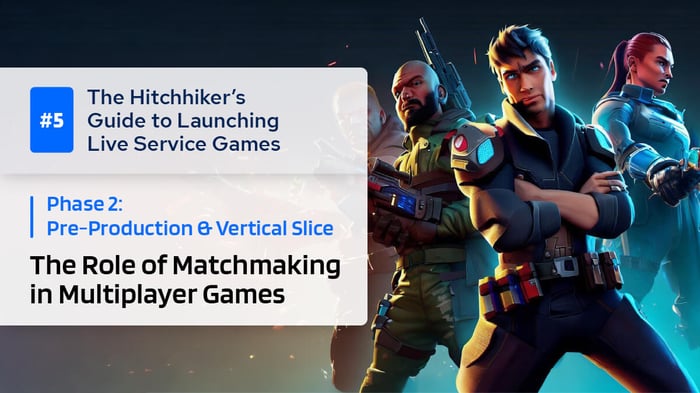Getting Started
Introduction to AccelByte Gaming Services (AGS)

Backend Services
Skip boring dev work with plug-and-play systems for 80% of your game’s backend

Backend Customization
Build 20% of the backend that makes your game unique without managing it

Server Orchestration
Automate spinning up and scaling servers globally for smooth, low-latency sessions

Build Distribution
Deliver builds faster to testers worldwide so you can ship multiple times a day

Crash Reporting
Catch and fix bugs before players see with real-time crash data and full context

Tools & Utilities
Monitor gameplay, test your setup, and tweak your game without juggling external tools
Introduction to AccelByte Gaming Services (AGS)
Learn to use AGS with our demo game "Byte Wars"
Connect and get support with other members of the AccelByte Community
Submit and review tickets while directly connecting with AccelByte
Join our Discord for support, insights, and networking!

In live game development, matchmaking and multiplayer features hold immense significance, as they play a crucial role in shaping the player experience and ultimately determining the success of multiplayer games. These features are responsible for hooking us up with fellow players, creating a virtual hangout where we can compete, connect, and have a good time. It's about bringing players together, matching them up based on their skills and preferences to ensure the fun never stops, and the game keeps going strong.
In this chapter of The Hitchhiker’s Guide to Launching Live Service Games, we explore matchmaking and multiplayer aspects of live game development, their importance and impact on players, and technical areas that may require some extra attention.
Matchmaking connects players with opponents or teammates of similar skill levels, creating balanced and fair matches. This ensures that players can compete on a level playing field, promoting healthy competition and avoiding frustration from encountering significantly stronger or weaker opponents. It helps to keep players challenged and motivated to improve their skills, thereby contributing to long-term retention and a thriving player base.
The multiplayer aspect of games allows players to collaborate, cooperate, or compete with one another in real time. This creates a dynamic and unpredictable gaming experience that can be immensely gratifying.
There are different types of multiplayer games that cater to various preferences and playstyles. Some multiplayer games fall into the cooperative category, where players team up to beat the campaign or tackle challenging missions together. On the other hand, there are match-based multiplayer games like Halo or Call of Duty, where players engage in intense competitive battles. For those seeking a more immersive experience, there are large-scale MMO (Massively Multiplayer Online) games like World of Warcraft, where players can interact in vast virtual worlds and undertake epic quests together.
Even in games that might not primarily focus on multiplayer, such as Elden Ring, there exists a semi-multiplayer aspect. In titles like Elden Ring, players have the opportunity to visit other players' worlds, creating a unique blend of single-player and multiplayer elements. This hybrid approach allows players to share experiences and occasionally collaborate, enhancing the overall gaming journey.
Regardless of the type of multiplayer gameplay, the multiplayer feature fosters camaraderie among players and encourages them to strategize, communicate, and work together. This collaboration not only enhances the gaming experience but also leads to deeper engagement with the game itself.
Matchmaking systems are the secret sauce of multiplayer gaming, making sure players come together smoothly and keeping the competition on a level playing field. Below are several reasons why having a strong matchmaking system in your live game is an absolute must.
Well-designed matchmaking systems enhance player engagement and ensure long-term retention in multiplayer games. By carefully connecting players based on their skill levels, preferences, and other relevant factors, these systems create a more enjoyable and challenging gaming experience.
Without proper matchmaking, players may encounter opponents who are significantly stronger or weaker than they are, resulting in either overwhelming defeats or unchallenging victories.
Imagine you're all pumped up for a gaming session, ready to conquer the virtual world, but then you end up facing opponents who are too powerful or too easy to beat. Not a fun match. That's what happens without proper matchmaking. Such imbalanced matches can lead to frustration and dissatisfaction, causing players to lose interest in the game. A well-designed matchmaking system mitigates these issues, making the gaming experience more enjoyable and consistent.
Fair matchmaking encourages players to continuously learn and improve their skills. When players face challenges within their reach, they are more likely to try to develop their abilities. This ongoing learning process creates a sense of progression, where players can see tangible improvements in their performance over time, further reinforcing their commitment to the game.
Matchmaking and multiplayer features plays a major impact on the player experience, influencing engagement, social interaction, competitive thrill, and overall satisfaction in the dynamic world of multiplayer gaming. Discover how these features take gaming to a whole new level.
Matchmaking and multiplayer features have an innate ability to connect players socially, transcending cultural and geographic differences through incredible shared experiences. This social interaction creates a sense of belonging and camaraderie. The shared experiences and interactions within the game build strong communities, turning the gaming environment into a virtual social space.
Multiplayer games allow players to team up or compete against one another in real-time. Through these interactions, players can meet new friends, forge healthy rivalries, and find mentors or someone they'd like to take under their wing—even if they are located in different parts of the world. These connections not only enrich the gaming experience but can also extend beyond the game, strengthening the overall social fabric of the community.
Multiplayer features keep games fresh, injecting an element of unpredictability into gameplay that is virtually impossible to replicate through other means. The actions of other players can significantly impact the experience, creating excitement, surprise, and emergent gameplay scenarios. This dynamism keeps players engaged and invested in the game over the long term.
Matchmaking ensures that players are matched with opponents of similar skill levels, leading to intense and competitive matches. The thrill of challenging opponents and striving to outperform others can be highly motivating, encouraging players to return for more.
Multiplayer environments expose players to diverse playstyles and strategies. As they encounter various challenges, players can learn from others, adapt their tactics, and improve their skills. This continuous learning curve contributes to a sense of achievement and progression, fostering player satisfaction.
Incorporating matchmaking and multiplayer features in your live game can offer several benefits. Keep reading to learn more about how matchmaking and multiplayer features affect a game.
A robust matchmaking and multiplayer system creates a more enjoyable and immersive gaming experience, increasing player retention. When players feel engaged, connected, and challenged, they are more likely to continue playing the game over an extended period.
Satisfied players are more likely to recommend the game to others, leading to organic community growth. Positive word-of-mouth and active communities attract new players, further fueling the game's success. Multiplayer games often have dedicated fan bases that form communities around shared interests and experiences. Matchmaking systems enable players to connect with others with similar gaming preferences and skill levels, laying the foundation for these communities. As players repeatedly encounter familiar faces in matches, they develop a sense of belonging and camaraderie within the game's community.
Engaged and dedicated players invest in the game through in-game purchases, subscriptions, or microtransactions. The revenue generated supports ongoing development, updates, and improvements, ensuring the game's longevity and continued success.
The multiplayer aspect of games plays a pivotal role in driving these transactions. The competitive nature of multiplayer games encourages players to invest in cosmetic items, allowing them to stand out within the gaming community or among friends. These purchases, such as unique skins or personalized accessories, offer a way for players to create distinct visual identities.
Additionally, multiplayer modes often incorporate progression systems with rewards tied to achievements, motivating players to invest in purchases that expedite progress or grant access to exclusive items. The social dynamics of multiplayer experiences further stimulate transactions, as players seek virtual items to enhance interaction, such as expressive emotes or gestures. Overall, the combination of competitiveness, personalization, and social engagement within multiplayer games forms a foundation for player-driven transactions, ensuring ongoing development, updates, and improvements that contribute to the game's long-term success.
Critical considerations in matchmaking design are crucial to ensuring fair and engaging player experiences, as they address challenges in skill balancing, match criteria determination, and overall system effectiveness, leading to the success of multiplayer games. Below are some variables to consider.
Creating skill-balanced matches is essential for providing all players with a fair and enjoyable gaming experience. However, it can pose several challenges due to the diverse skill levels within the player base.
Determining appropriate match criteria involves considering various factors that affect the quality of matches and player experiences.
Match Quality vs. Waiting Time: There is a trade-off between the quality of matches and the time players have to wait for a game. Tightening skill requirements may lead to longer waiting times, while loosening them can result in less balanced matches.
Skill vs. Connection Quality: Striking a balance between matching players based on skill and ensuring low-latency connections is essential. A compromise may be necessary if there are no closely matched players nearby.
Playlist Variety vs. Focused Experiences: The breadth of available playlists brings with it another trade-off. A diverse range of gameplay experiences caters to varied player preferences. However, an excessive number of playlists can fragment the player base, leading to smaller populations in each playlist. Developers must consider the balance between offering a rich variety of experiences and ensuring a healthy player pool for engaging matches, and reasonable queue times.
Addressing technical complexities in multiplayer games is essential for providing seamless gameplay experiences, maintaining server performance, and fostering a positive gaming environment. Take these technical complexities into account.
Minimizing latency and ensuring smooth online multiplayer experiences are critical to providing an enjoyable and responsive gameplay environment. Latency is the delay between a player's action and its corresponding effect in the game world. High latency can lead to laggy gameplay and negatively impact player experiences.
Fair gameplay is maintained in multiplayer games through network synchronization and latency compensation, ensuring consistent game state and interactions for all players. These mechanisms facilitate real-time interactions, providing a seamless and immersive experience, which enhances player engagement and allows for better responsiveness and immersion in the gaming environment.
Handling large player populations and maintaining performance in multiplayer games can be daunting, especially as player numbers grow.
Increased Server Load: More players mean a higher server load, which can lead to performance degradation and potential server crashes.
Matchmaking Efficiency: As the player base expands, finding suitable matches quickly and efficiently becomes more challenging, leading to longer waiting times.
Server Infrastructure Costs: Supporting a growing player population requires a robust server infrastructure, which can be expensive to maintain.
Enhancing multiplayer experiences involves effective player grouping, team balancing, and proactive measures to manage player behavior, fostering a positive and engaging gaming environment. Keep reading for more on enhancing multiplayer experiences.
In multiplayer gaming, grouping players through party systems and solo queues enhances social interaction and teamwork while promoting fair competition. Additionally, implementing dynamic team balancing and matchmaking adjustments leads to improved gameplay experiences, reduced player frustration, and balanced skill development, as players face appropriate challenges and engage in exciting, closely contested matches.
In multiplayer gaming, promoting positive behavior and mitigating toxicity are essential for maintaining a healthy and respectful gaming community. Positive reinforcement, communication tools, and in-game reporting systems encourage good sportsmanship and teamwork, fostering a positive atmosphere. To tackle toxicity, developers implement reporting systems, community moderation, and penalties for offenders, while also integrating anti-cheat measures and regular updates to protect fair gameplay and the integrity of the game.
Incorporating player feedback is a vital aspect of game development, especially concerning matchmaking systems. Player feedback provides valuable insights into the effectiveness of matchmaking mechanisms, enabling developers to understand player preferences, pain points, and overall satisfaction levels. By actively seeking and incorporating player feedback through surveys, in-game feedback mechanisms, user behavior analysis, community engagement, and A/B testing, developers can make informed decisions, refine matchmaking algorithms to create a positive and engaging multiplayer environment and improve player sentiment and emotional investment by giving them a voice and tangible sense of impact.
Player feedback bridges the gap between developers' intentions and player experiences, impacting player enjoyment, challenge, and retention. Understanding how players perceive and interact with the system empowers developers to fine-tune matchmaking mechanics to meet player needs better. Regular surveys and in-game feedback forms provide structured feedback, while user behavior analysis reveals patterns and trends. Engaging with the gaming community and utilizing A/B testing allow developers to collect quantitative and qualitative insights, fostering a sense of community and enabling real-time engagement with the matchmaking process. By valuing player perspectives, developers can create compelling multiplayer experiences, promoting fair competition, meaningful interactions, and player satisfaction, ultimately contributing to the game's overall success and longevity. Game developers should define their standards for "good" (e.g. balanced MMR, or fast matching time) and optimize the matchmaking system towards their desired outcome.
In a nutshell, matchmaking and multiplayer features are the heart and soul of creating awesome gaming experiences that go way beyond just having fun. These elements bring us together in dynamic virtual worlds, sparking competition and bonding among players from all corners of the globe. By carefully considering the right design factors, tackling tech hurdles, and listening to player feedback, developers can level up the matchmaking game, guaranteeing fair play, smooth gaming, and less drama. With all the cool new tech trends on the horizon, the future of matchmaking and multiplayer is looking brighter than ever, promising more epic moments and forming tight-knit gaming communities that are here to stay.
Are you venturing into the realm of live game development? Check out The Hitchhiker’s Guide to Launching Live Service Games, your comprehensive resource for understanding the intricacies of the game development process.
Curious about how Accelbyte can assist you with your backend requirements? Reach out to our team for a demo and explore the possibilities.
Reach out to the AccelByte team to learn more.